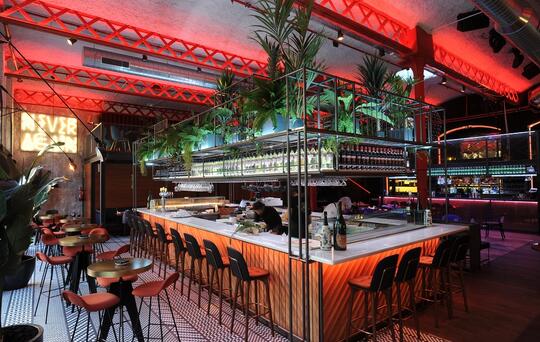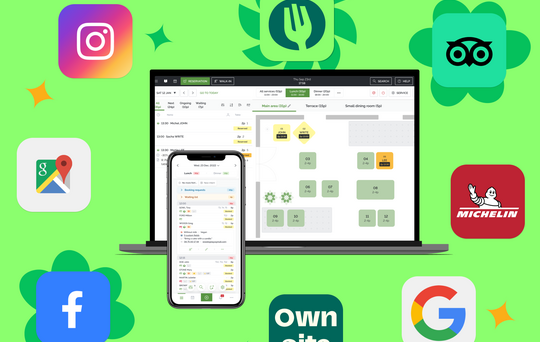From new hire to hospitality hero: a comprehensive guide to restaurant staff training

- • Why should you train your restaurant staff?
- • Developing a restaurant staff training program
- • Try TheFork Manager today
- • Essential restaurant staff training topics
- • How to train restaurant staff
- • Tips for successful restaurant staff training
- • Restaurant training program and more
- • Empty tables and ever-increasing costs?
Are you the owner of a fine dining establishment and want to go the extra mile to enhance your operations? Consider implementing structured training sessions for your restaurant staff. It’s not just about imparting the basic principles and skills of restaurant operation; it’s about creating an excellent customer experience that keeps your guests coming back for more.
Whether you wish to refine your existing plan or introduce a new one, this guide covers every aspect of restaurant staff training. We will also provide practical insights, tips, and tools that can truly elevate your service and achieve the desired results.
Why should you train your restaurant staff?
It is often said that you never stop learning. This statement is particularly true when it comes to working in a restaurant. Therefore, investing in staff training can secure the success of your restaurant, improving the service and leading to a better dining experience. This will make your guests eager to return to discover what you have in store for them.
We cannot stress enough how critical a well-structured training plan is for optimising efficiency. Streamlining operations helps each team member know exactly what to do in every situation. Consequently, your workflow will become smoother enhancing your staff’s productivity.
Having a skilled restaurant manager will also reduce the number of errors made, as they will know exactly what to do in any given situation, working to make customers feel at ease and enjoy themselves.
Last but not least, training will boost employee morale and retention. Happy team members will foster a positive work environment, which is especially important considering the hospitality sector’s high turnover rates.
Developing a restaurant staff training program
If you are developing a restaurant staff training program for the first time, you’re probably wondering how to approach it.
- Identify your restaurant’s specific needs. This step requires an objective assessment of your current performance. Gather feedback directly from your employees and guests to determine which areas can be improved.
- Set clear and achievable goals for your training program. This will help you align your restaurant’s standards with customer service expectations, leading to the full satisfaction of both your guests and staff.
- Find the best training method. Consider structuring your plan to include both theoretical and practical training, which will allow you to accommodate different learning styles.
- Provide valuable resources, such as detailed guides, handbooks, PDFs and other useful learning material, ensuring full accessibility.
- Tailor your restaurant staff training program to different roles to ensure consistent development in every area.
Training needs assessment
Implementing restaurant staff training is undoubtedly a useful practice. However, it is important to be aware of any other knowledge and skill gaps in your workforce. This is where the Training Needs Assessment comes into play.
First, observe your employees during their shifts and pinpoint their weaknesses. Common mistakes, customer feedback and operational inefficiencies are critical elements that should be addressed quickly.
Surveys and self-assessments are invaluable, as they encourage your staff to evaluate, giving them a stake in their own training. You will gain an insight into their confidence levels and areas where they feel they are lacking. This introspective method gives an overview of the gaps within your team, involving your employees in the training process and fostering a culture of continuous improvement.
Try TheFork Manager today
Essential restaurant staff training topics
When approaching restaurant staff training, there are some core areas that your program must cover to ensure that every team member is well-prepared for their respective roles.
Food and beverage knowledge is the beating heart of a dining establishment, so it’s important that your restaurant staff training plan covers:
- How to store foodstuffs properly, according to current food safety regulations
- How to handle items during service and delivery
- How to present food and drink
When it comes to serving, there are some common best practices that waiters and waitresses should follow to maintain high standards. They will accompany customers throughout their restaurant experience and, consequently, they need to know:
- How to welcome customers and make them comfortable
- How to take orders — they need to know the menu off-by-heart to provide suggestions based on dietary restrictions and be able to answer any customer questions
- How to serve alcohol responsibly
Another core topic is food safety. Every dish must be prepared following hygiene guidelines to ensure it is safe to eat. These are not just best practices, but basic fundamentals that can protect both employees and guests.
Your restaurant training should go into detail about::
- Cross-contamination and how to avoid it
- Sanitation protocols
- Compliance with national regulations. In the UK these include the Food Safety Act 1990, the Food Safety Act 1999, and the General Food Law.
Beyond the basic principles, a key part of working in a restaurant is developing soft skills. Communicating with guests smoothly, interacting with team members based on their background and abilities, and conflict resolution are all qualities that help maintain a positive work environment and boost the customer experience.
How to train restaurant staff
Training enhances the learning process for your restaurant staff to provide them with the skillset needed to achieve a common goal: success. Implementing restaurant staff training programmes can lead to better results.
If you opt for a practical approach, on-the-job training is the most suitable method, allowing new hires to learn as they go during their shifts in the restaurant.
On one side, they will gain hands-on experience and immediate feedback; however, this kind of learning can be overwhelming and might disrupt regular service.
Classroom instruction is a more theory-based method where you can cover every key restaurant-related topic, from restaurant staff policies, the dos and don'ts in the restaurant, hygiene practices, and so forth.
Whilst there is a specific, structured environment without distractions, the downside could be that there is no practicality or real-world application as in on-the-job training.
Video tutorials and online courses offer a more flexible approach, allowing employees to learn at their own pace and revise when needed.
In addition, everyone has access to the necessary information through various materials — restaurant staff training manuals, PDFs, PPTs, videos, and audio. However, this method is rather impersonal, so it could be lacking in terms of engagement.
The best way to begin developing an effective restaurant staff training program is to create a learning checklist so that you can monitor your team’s progress and introduce interactive activities, such as training games, to help memorise key concepts.
Tips for successful restaurant staff training
Creating a positive and engaging learning environment is crucial for restaurant staff training. Here are some practical tips to ensure your training program is a success:
- Role-playing exercises that simulate real-life scenarios. This will help to enhance the confidence and skills of your employees in a comfortable environment.
- Provide clear and regular feedback. After each training session, discuss areas of improvement directly with your team. This will help you understand where to focus your efforts.
- Encourage continuous learning. Training is not just a one-off experience. You should encourage your employees to develop their skills through online courses, magazines, and specialised blogs and handbooks.
Restaurant training program and more
For a restaurant to be successful, staff training must be paired with effective management. To stay up-to-date and constantly monitor your progress, TheFork Manager is the right platform for your business. With an all-in-one tool, you will be able to streamline bookings, optimise table rotation, and facilitate special offers and discounts.
Integrating a tailored assistant such as TheFork Manager is an impactful choice that simplifies management tasks while empowering your staff with technology that will give them invaluable insight into trends and customer behaviour.
TheFork is always by your side. We know how difficult developing a training plan can be, so we provide customised staff training sessions from an experienced team. We cover the basics as well as more advanced topics, ensuring that your employees are well-versed in using the platform to its fullest potential.
Empty tables and ever-increasing costs?
- Why should you train your restaurant staff?
- Developing a restaurant staff training program
- Try TheFork Manager today
- Essential restaurant staff training topics
- How to train restaurant staff
- Tips for successful restaurant staff training
- Restaurant training program and more
- Empty tables and ever-increasing costs?















